- Gorgeous stand
- Beautiful 4K display
- Wireless charging on the stand
- USB 4.0 port
- Solid CPU performance
- No ports upfront
- Mediocre webcam
- No discrete GPU at $1,500
Every PC brand has its own slate of all-in-ones (AIOs), and it’s hard for a new entry to stand out (especially among the best all-in-one computers). Lenovo has a compelling option on its hands with the Yoga AIO 9i, which promises not only one of the most unique designs we’ve seen, but also solid performance and some features you can’t find with other desktop PCs.
It’s a great AIO, and it’s arriving at a price that puts it in direct competition with Apple’s iMac M3 while offering a few clear advantages. Despite that, there are a few rough edges in the port selection and overall performance. This could be the ultimate iMac killer, but you’ll need to give into a few strange quirks.
Lenovo Yoga 9i AIO specs
| CPU | Intel Core i9-13900H |
| GPU | Intel Iris Xe or Nvidia RTX 4050 |
| Memory | Up to 32GB LPDDR5 |
| Storage | Up to 1TB |
| Display | 32-inch, 4K, IPS, 60Hz |
| Audio | 2x 2W tweeter by Harmon Kardon, 2x 5W woofer by Harmon Kardon |
| Webcam | 5MP IR camera with E-shutter |
| USB ports | 2x USB 3.2 Type-A, 1x USB 3.2 Type-C, 1x USB 4.0 Type-C, 1x 3.5mm headphone/microphone, 1x HDMI 2.1 out |
| Networking | Wi-Fi 6E, Bluetooth 5.2 |
| Price | $1,488 |
A beautiful AIO
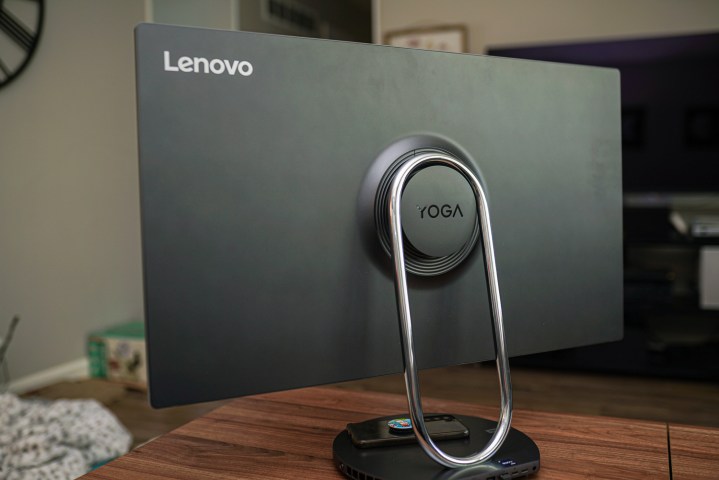
The Yoga AIO 9i looks great, that’s for sure. It’s a typical AIO layout, with the guts of the machine stuffed into the base, but the unique stand makes the Yoga AIO 9i look special. It’s a metal ring that looks like it impossibly floats on the base and reaches up to wrap around a circular Yoga badge on the back.
This stand gives you a bit of adjustment, allowing you to tilt the screen up and down, but it doesn’t offer any height adjustment. Most AIOs don’t, for what it’s worth, and it likely wouldn’t have worked with Lenovo’s stand design. The massive 32-inch screen would definitely benefit from height adjustment, however.

Down at the base, Lenovo keeps the design straightforward with a matte gray finish that’s contrasted with a stark silver Lenovo badge. It’s simple, and that’s largely due to the fact that the surface of the base is a wireless charging pad. Pop your phone on it while you’re working, and it will automatically keep it topped off.
This is a great feature, but you have to mind the placement. Too close to the front or too close to the stand, and the wireless charging won’t kick in. The sweet spot is in the middle, just below the Lenovo badge. Thankfully, Lenovo places a wireless charging icon in that exact spot so you know where to set your phone.
Ports all at the back
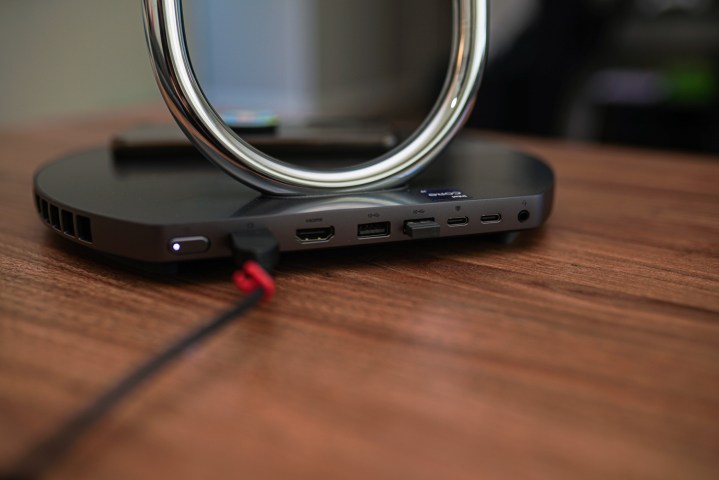
Lenovo positions all of the connectivity for the Yoga AIO 9i on the back of the machine, keeping your cables tidy. I enjoy how clean the final look is, but I consistently found myself struggling to swap items out of the strange split of USB ports.
Around the back, you have access to two USB-A 3.2 ports, an HDMI 2.1 output, a 3.5mm headphone/microphone jack, a USB-C 3.2 port, and a USB-C 4.0 port, along with the power button and DC adapter port. It’s great to see USB 4 on display here, but I was constantly missing an extra USB-A port. Between a keyboard and mouse, either wired or wireless, you’re likely to occupy both, forcing you to a USB-C port for anything extra.
The placement is a problem, too. Although I appreciate that most of the cables are around the back to keep everything looking tidy, an extra USB-A port at the front would go a long way. As it stands now, the Yoga AIO 9i feels like it’s missing one USB port, and struggling to reach your head around the back to plug something in is a hassle.
A stunning screen
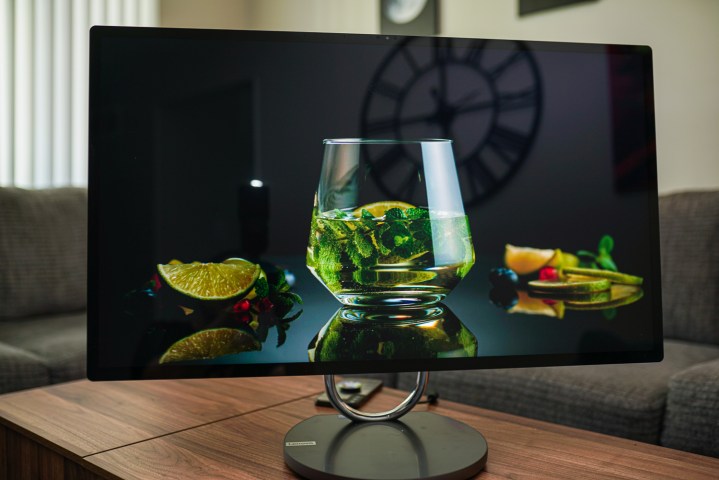
One of the most remarkable aspects of the Yoga AIO 9i is the screen. I’ve reviewed a lot of monitors, and Lenovo’s display here goes toe-to-toe with the best monitors you can buy. This is a 32-inch display with a 4K resolution. It’s locked to a 60Hz refresh rate, but I’d gladly trade smoothness for this degree of quality.
The most immediate impression the display leaves is clarity. The 4K resolution on a 32-inch screen makes fine details like text look sharp, and the glossy finish leads to colors popping off the screen. As I’ll get to next, the display is extremely bright, too, offering solid HDR performance for movies and the occasional game.
What you need to know is that the display looks fantastic, but I have some technical bits to back that up. Starting with brightness, the screen reached an impressive 640 nits at its highest, which is one of the highest numbers I’ve ever recorded. It’s so bright, in fact, that you probably won’t want to run the display at maximum brightness most of the time.
Color coverage was also exceptional with 100% coverage of sRGB and 97% coverage of the extended DCI-P3 color space. That’s on the level of a premium display like the Samsung Odyssey OLED G8. This isn’t an OLED monitor, but the color coverage is fantastic. The color accuracy wasn’t perfect, with an average error of 1.51, but that’s acceptable for some lightweight color work in apps like Photoshop.
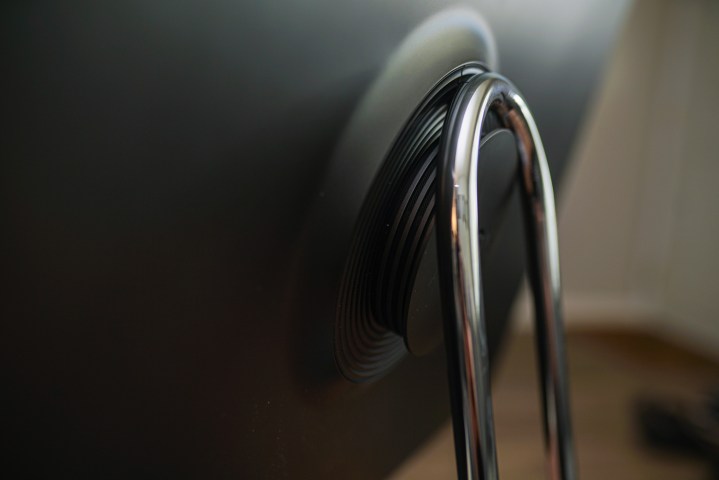
For audio, Lenovo offers a quad-speaker array, split up as two 2-watt tweeters and two 5-watt woofers, all created by Harman Kardon. The audio is solid, though it can’t rival what Apple has achieved on the iMac, even with Dolby Atmos support in tow.
Good keyboard, OK mouse
Lenovo includes a wireless keyboard and mouse combo with the Yoga AIO 9i that is surprisingly good. The ultrathin keyboard is snappy and responsive, and the mouse has a solid weight to it, with a bump in the back that helps it sit comfortably in your palm.
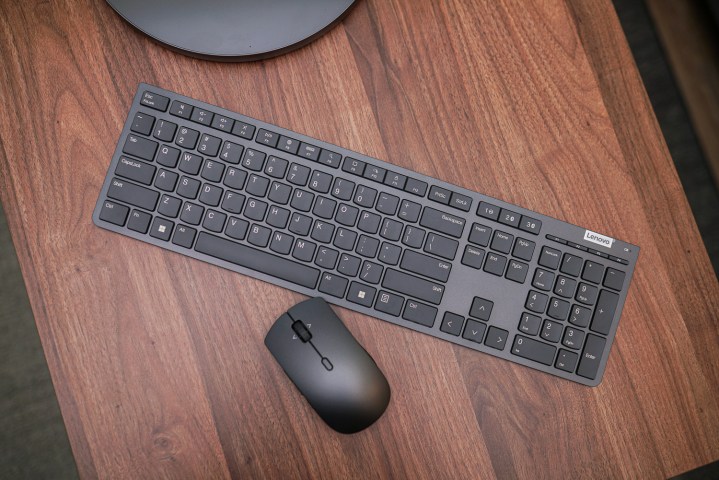
Both sync up with a single wireless USB dongle, perhaps explaining why Lenovo only includes two USB-A ports. On top of that, Lenovo allows two Bluetooth connections on both peripherals, so you can easily swap them between devices.
These are still stock peripherals, though, and you’ll get a much better feel with your own keyboard and mouse. Out of the two, I’d replace the mouse first. The keyboard is comfortable, and it feels premium thanks to an aluminum top. The mouse, on the other hand, is entirely plastic and feels cheap, no matter how comfortable it is.
All about the CPU
The Yoga AIO 9i is based on a mobile processor — Intel’s Core i9-13900H — so although it’s technically a desktop, you should expect performance on the level of a high-end laptop. The 14-core mobile part holds up well, offering six performance cores and eight efficiency cores, and it can clock up to 5.4GHz. It’s not always a showstopper, though.
In a multi-core test like Cinebench R23 or Geekbench 6, the Yoga AIO 9i often loses to laptops like the Surface Laptop Studio 2 with a weaker Core i7-13700H. Compared to the 24-inch iMac with the M1, however, the Yoga AIO 9i is leagues ahead. It takes a slight back seat to the M2 Pro inside the Mac mini, but it’s still close.
Single-core performance is where the Yoga AIO 9i shines. Unless you scale up to one of Intel’s HX-series parts or a desktop chip, you’re not going to find better single-core performance than what’s on display here.
| Lenovo Yoga AIO 9i (Core i9-13900H) | Apple Mac mini (M2 Pro) | iMac (M1) | Surface Laptop Studio 2 (Core i7-13700H/RTX 4060) | |
| Cinebench R23 single/multi | 1,909 / 13,746 | 1,649 / 14,812 | 1,515 / 7,785 | 1,852 / 13,777 |
| Geekbench 6 single/multi | 2,840 / 13,475 | 2,684 / 12,765 | N/A | 2,486 / 13,228 |
| Handbrake (seconds, lower is better) | 89 seconds | N/A | 154 seconds | 77 seconds |
| PCMark 10 | 6,358 | N/A | N/A | 7,507 |
| Pugetbench for Premiere Pro | 299 | N/A | N/A | 604 |
| 3DMark Time Spy | 2,100 | N/A | N/A | 9,311 |
| 3DMark Fire Strike | 5,803 | N/A | N/A | 20,580 |
How does all of this play out in real applications, though? This is a general productivity machine, so it’s not surprising that more demanding tasks like video editing and transcoding don’t show a lot of promise. In Handbrake, the Yoga 9i took nearly a minute and a half to complete the transcode, while even laptops with the Core i7-13700H can complete it about 10 seconds faster. The Yoga AIO 9i managed to cut the time of the iMac M1 nearly in half, but that’s quite an old machine at this point.
Similarly, in PugetBench for Premiere Pro, the Yoga AIO 9i posted the lowest overall score we’ve recorded, though that’s with fairly limited data on the most recent version. It managed to fall just short of the MacBook Air with the M2 chip. We don’t have data for the Mac mini with the M2, though it should provide a similar level of performance.
In apps like these, the big missing piece is a discrete GPU. The Yoga AIO 9i relies on integrated Intel Iris Xe graphics, vastly slowing down apps like Premiere Pro and extras like gaming. You can see that reflected in 3DMark scores. Lenovo says the machine supports up to an Nvidia RTX 4050, though there isn’t a configuration available with that GPU at the time of publishing. The extra GPU power would help a lot in some of these demanding apps.
The real question for the Lenovo Yoga AIO 9i is how it will stack up to the iMac M3, which is slated to launch in short order. Both machines are around the same price, and although Lenovo certainly has the advantage with its screen, the GPU performance offered by the M3 may be too big to ignore.
A lacking webcam
The Yoga AIO 9i includes an integrated 5MP camera, along with a dual microphone array, and the only way to describe it is “serviceable.” It’s not very sharp, and it’s prone to show some grain, even in brightly lit environments. But it will get you by for video calls with solid audio quality. Just don’t turn down the lights too much if you want the webcam to look decent.
Should you buy the Lenovo Yoga AIO 9i?
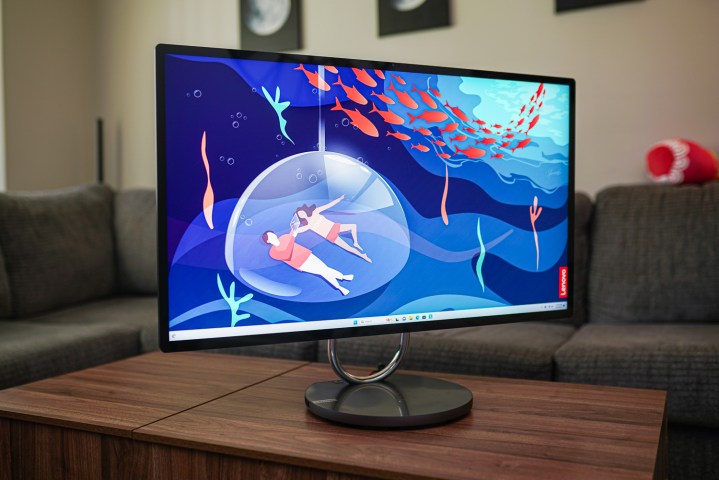
Lenovo is offering a lot in the Yoga AIO 9i. There are certainly cheaper options, most of which rely on much weaker mobile processors, but Lenovo offers a lot of grunt for the $1,500 it’s asking. This is a high-performance AIO that hits the mark with an excellent screen and extra features like wireless charging in the base — and at a price that’s hundreds less than a machine like the HP Envy 34.
Still, there are some issues. The webcam isn’t great, and for as much performance as the CPU offers, a dedicated GPU would do wonders to push this desktop further. In addition, the port selection isn’t great, which is a shame for a desktop that’s supposed to offer everything you need without any additional accessories.
For Windows users looking for a showstopping display and solid overall performance, the Lenovo Yoga AIO 9i is a great option. If you’re on the fence, though, I’d recommend shopping around for a deal and considering the 24-inch iMac with the M3, which will likely offer higher overall performance.





